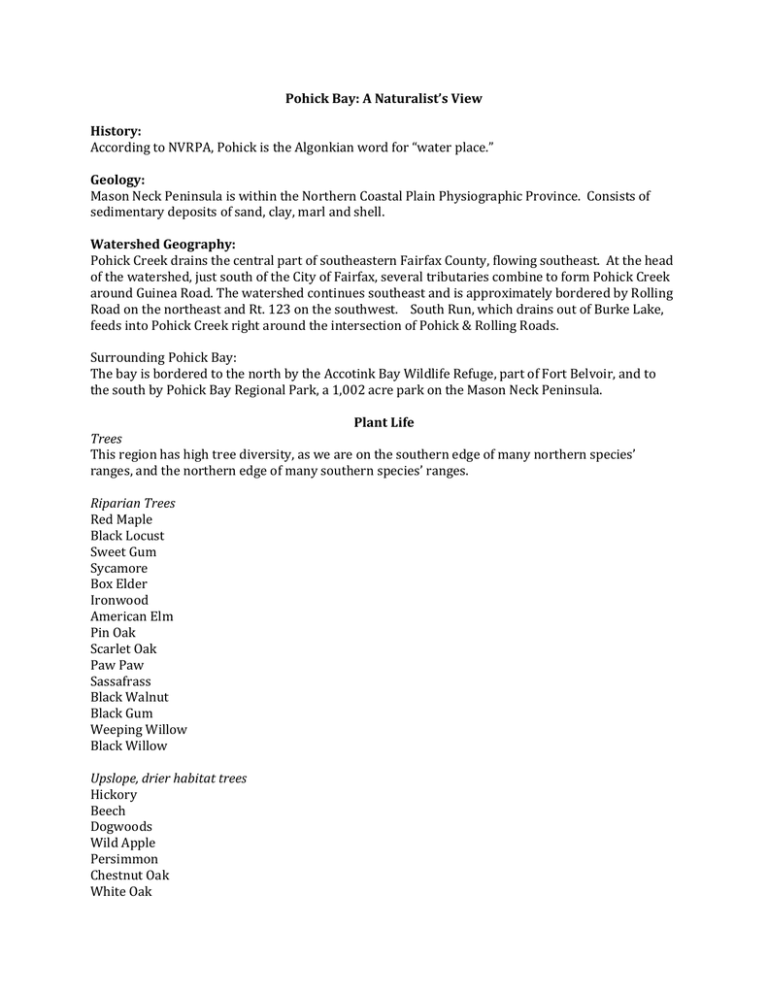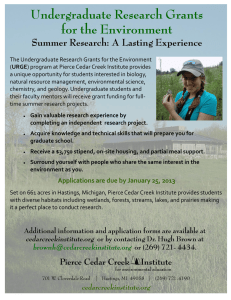Pohick Bay: A Naturalist’s View History: Geology:
advertisement

Pohick Bay: A Naturalist’s View History: According to NVRPA, Pohick is the Algonkian word for “water place.” Geology: Mason Neck Peninsula is within the Northern Coastal Plain Physiographic Province. Consists of sedimentary deposits of sand, clay, marl and shell. Watershed Geography: Pohick Creek drains the central part of southeastern Fairfax County, flowing southeast. At the head of the watershed, just south of the City of Fairfax, several tributaries combine to form Pohick Creek around Guinea Road. The watershed continues southeast and is approximately bordered by Rolling Road on the northeast and Rt. 123 on the southwest. South Run, which drains out of Burke Lake, feeds into Pohick Creek right around the intersection of Pohick & Rolling Roads. Surrounding Pohick Bay: The bay is bordered to the north by the Accotink Bay Wildlife Refuge, part of Fort Belvoir, and to the south by Pohick Bay Regional Park, a 1,002 acre park on the Mason Neck Peninsula. Plant Life Trees This region has high tree diversity, as we are on the southern edge of many northern species’ ranges, and the northern edge of many southern species’ ranges. Riparian Trees Red Maple Black Locust Sweet Gum Sycamore Box Elder Ironwood American Elm Pin Oak Scarlet Oak Paw Paw Sassafrass Black Walnut Black Gum Weeping Willow Black Willow Upslope, drier habitat trees Hickory Beech Dogwoods Wild Apple Persimmon Chestnut Oak White Oak Black Oak Northern Red Oak Black Cherry Hackberry Catalpa Understory Mountain Laurel Spicebush Various Viburnums Pokeweed Mock-Orange Ironweed Aquatic plants Yellow Pond Lily Arrowhead Arrow Arum Pickerelweed Spatterdock Cattail Wild Rice Invasive plants Microstegium Bittersweet Ailanthus Multiflora Rose English Ivy Garlic Mustard Norway Maple Much of the original upland vegetation was cleared for agriculture, and remaining forests cut repeatedly. Ecological communities today include: Seven different kinds of habitat ID’d in a 1999 Environmental Resources survey: hardwood forest (majority of park), mixed forest, pine forest (mostly Virginia Pine, S. portions of park), wetland (4 kinds: palustrine forested, palustrine scrub-shrub, palustrine emergent, and riverine emergent,) open water, upland field, and edge habitat. Secondary mixed oak/heath forests on the ridges Mixed Hardwood forest (beech/oak/tulip poplar) on mesic slopes & ravines Oak/Beech and heath forests with understories of mountain laurel are common on steep slopes and bluffs Occasionally streams have cut into tertiary shell deposits or limesands, the soil is a lot more alkaline and you get rare mesic and dry calcareous forest communities. Many palustrine & estuarine wetland ecosystems all throughout the province. Those of conservation concern include seepage swamps, seepage bogs, Coastal Plain depression ponds, tidal swamp forests and tidal freshwater marshes. Animal Life Birds Dozens, if not hundreds, of species of birds depend on wetlands such as this for some part of their survival. Birds that depend on wetlands include waterfowl, grebes, rails and their allies, wading birds, cormorants, kingfishers, shorebirds, gulls and terns, and some birds of prey such as ospreys and eagles. Other types of birds that thrive in and near wetlands include an extensive variety of passerines (thrushes, wrens, blackbirds, mimids, warblers, etc.), woodpeckers, owls, turkey, and quail. Ospreys Osprey return to the Pohick Bay area in the early Spring, around mid-March, and usually begin rebuilding and refurbishing the old nest of the previous year. Their nests are rather large and old well constructed ones may be four feet in diameter. After the birds have built their nests, the female will lay several eggs. The eggs take about 40 days to hatch, but the little fish hawks will not be ready to fly for another 50 days or more. If you add up all this time and add a little to be on the safe side you can see that it is best to stay away from Osprey nests from the beginning of March to about the end of June. By August many of the fish hawks will begin their journey south not to return until the following March. Eagles The trip up Pohick Creek is best taken slow as there is always a chance to see an eagle. Although the creek is wide by creek standards the flight of an eagle across it is very short and if you have you mind on paddling fast you will definitely miss some superb sights. Bald Eagles nest among some of the taller trees bordering the creek, so keep an eye out. Large standing dead trees in the water are favorite resting spots for eagles especially in the spring. Great Blue Herons There are many great blue herons that fish here, and nesting sites on the other side of the peninsula. Fish Catadromous: Catadromous fish hatch in the ocean but live their lives in freshwater, returning to the ocean to spawn and die. The American Eel is catadromous. Anadromous: Anadromous fish hatch in freshwater, live in tributaries and streams for a few years, then move out to open ocean. After they mature they return to freshwater to spawn. Anadromous species that can be found around here include Alewife, American Shad, American and Shortnose Sturgeon?, Herrings, Sea Lamprey, and Striped Bass. Anadromous species are particularly vulnerable to upstream dams that prevent them from reaching spawning grounds. (think salmon) Potamodromous: Potamodromous species hatch in tributary streams and live their adult lives in large freshwater bodies such as the Potomac, then return to the streams to spawn. Potamodromous species include Smallmouth Bass and Yellow Perch. Tidal wetlands are critical to the survival of all fish mentioned above. Bowfin Lamprey Anadromous American Eel Catadromous Snakehead questions: One was caught in Pohick Bay in May of 04. They’ve also been caught in Kanes Creek, Little Hunting Creek, a lot in Dogue Creek, and other locations. All snakehead species are freshwater fish. This means that they cannot tolerate the saltwater of the Chesapeake Bay or lower tidal sections of rivers like the Potomac, Rappahannock, James, or other rivers. Therefore if they’re found upstream in other rivers, they’ve been dumped there. Reptiles Snapping Turtle Painted Turtle Red-bellied Slider Musk Turtle Box Turtle Five-Lined Skink Northern Water Snake Eastern Garter Snake Black Rate Snake Northern Brown Snake Northern Ring-neck Snake Milk Snake Black Racer Rough Green Snake Copperhead Amphibians Salamanders Red Spotted Newt Eastern Tiger Salamander Spotted Salamander Marbled Salamander Redback Salamander in forested areas nearby Green Frog Wood Frog Bullfrog Spring Peeper Southern Leopard Frog Pickerel Frog American Toad Mammals Red & Grey Fox Coyote Raccoon Oppossum Mink? Long-tailed Weasel River Otter? Muskrat Beaver Woodchuck Skunk Cottontail Rabbit? Grey Squirrel Flying Squirrel 7 or 8 kinds of bats including Red, Big Brown, Hoary, Myotises, Pipistrel, and Silver-Haired Chipmunks 10+ species of Mice, Rats, Moles, Voles, Shrews White-Tail Deer Feral dogs and cats Special or Rare Ecological Attributes: This peninsula boasts several hundred acres of hardwood forests consisting of oaks, holly, hickory and other species of trees. In addition, several wetland areas are also found in Mason Neck. Pohick Bay Regional Park is within the Northern Coastal Plain Physiographic Province, which goes from Fall line to the west to the James River in the south. There are many naturally-managed areas and conservation sites within the province, which cover over 380 known populations of federally threatened or endangered species. Only 1/3 of these occurrences are actually on protected land though. Attributes of freshwater tidal wetlands In winter, this area provides food and shelter for resident wildlife. In spring and fall thousands of migrating birds depend on this area as a waypoint, and during the spring and summer many migratory species nest and breed here, including [ ]. Fish also come in to spawn in the spring and summer. Warm protected wetlands such as these are the ocean’s nurseries. Some species are dependent on the wetlands (obligates); others benefit from it but can use other habitats (facultative users). The surrounding woods are critical to many species that use the wetlands: Muskrats and beavers burrow into the banks for their lodges, turtles hibernate and lay their eggs in the banks, birds and small mammals that forage in the wetlands often nest in the woods, and raptors use exposed perches at the edge of the woods to nest and hunt. The diversity of wildlife species in an area is dependent on the structural variety of the vegetation, both vertically and horizontally, the size of the area, and the presence and location of unique habitats. The food chain in wetlands is mostly detritus-based, though there are some herbivores such as muskrats, and some fish, reptiles, and insects. Fish and invertebrates such as mollusks feed on detritus, and they in turn are eaten by larger fish, birds, and small mammals and reptiles. Larger predators that feed on the secondary consumers include foxes, raccoons, owls, raptors, and snakes. Connection: When the deposition pattern of sediment is disrupted, or pollutants from upstream enter the water and poison it or encourage massive algal growth, what happens to detritivores & therefore everything above them?


